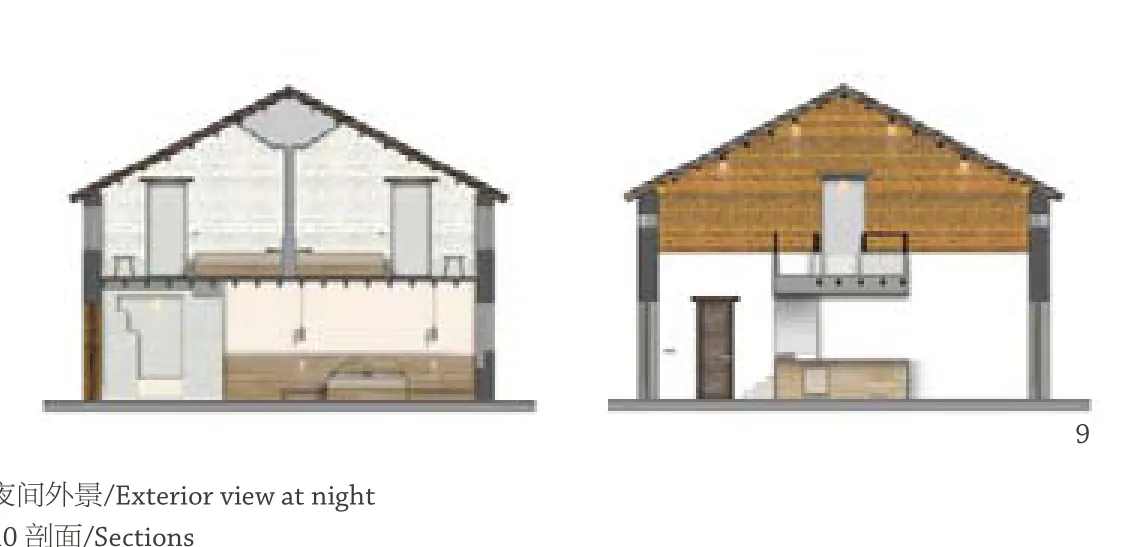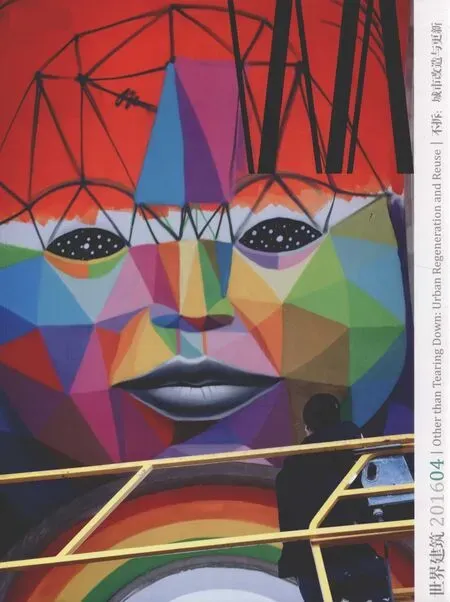云庐酒店,桂林,广西,中国
建筑设计: 刘宇扬建筑事务所,景会设计
Architects: ATELIER LIU YUYANG ARCHITECTS, ARES partners
云庐酒店,桂林,广西,中国
建筑设计: 刘宇扬建筑事务所,景会设计
Architects: ATELIER LIU YUYANG ARCHITECTS, ARES partners
“云庐”位于从广西桂林到阳朔的半途,是一座深藏于漓江沿岸好山好水之间的精品生态酒店。基地是当地一个自然村中的几户人家的多栋老农宅。项目便是从老农宅的改造开始,逐步梳理宅与宅之间的空间,并将一栋老宅拆除扩建为餐厅和客人可聚集的场所。设计采取一种对当地文化和周围村民的尊重和谨慎姿态,规划与景观设计在最大程度上融入了村落结构,并在周边不另设围墙或其他防护设施。在不破坏原外观的前提上,老的夯土建筑被改造为符合当代生活品质的酒店客房。新建的餐厅则用了一种更为低调的建筑语汇,以变截面钢结构和玻璃中轴门窗系统与毛石外墙、炭化木格栅和屋面陶土瓦形成一种材料对比,新老建筑形成的空间对话和延续感则是维系外来酒店与本土农村自然共生的基本法则。
在室内设计中,依然遵循了自然共生的法则。为了不影响依山傍水的好风景及与老村落的协调,低调的新建餐厅为一层楼高的坡屋顶建筑,并尽可能地降低了尺度,而室内空间在满足了空调等功能需求的前提下,尽可能地提升了层高,与建筑呼应,让空间明快、简洁、流畅。
原有农宅的室内虽然久经年代的风雨而显得破旧,但却不失空间上的趣味,典型的一栋青瓦黄土砖屋为三开间,中间为2层挑高的厅堂,两侧各有4小间房,二层为杂物储藏用。在改造中,保留了原建筑的木结构,黄土墙,坡屋面及顶上透光的“亮瓦”。在功能上一层的厅堂保留并设有吧台、沙发,是客人小聚的社交空间,客厅的两侧各有一间客房,厅堂中增加了通向二层的两间客房的楼梯。对于东西方向的室内墙面,只是作了必要的清洁和修缮,南北方向的墙面在土砖墙以内增加了轻钢龙骨石膏板墙,新旧墙体中间的空隙满足了所有管线、管井走向的需求。室内改造中侧重于思考现代人的生活方式与原生态空间的对话、空间本身与光影的对话、室内与室外空间的互动。在材料的运用上,选择了素面水泥、再生老木、竹子和黑色钢板,力求朴实、自然、简单的原则。

1外景/Exterior view

2 首层平面图/Floor 0 plan
3.4改造前外景/Exterior views before renovation
5.6模型/Models
Yun Lu is a boutique eco-resort nestled within a village of the northeastern part of Yangshuo resting along the dramatic landscape of the Li River. The site consists of nine renovated farm houses and one new addition which functions as an all-day dining restaurant for hotel guests. Taking on a sensitive approach to the local culture with villagers still living nearby, the overall planning and landscape design blends into the original village structure without creating new boundaries to the villagers. The rammed earthed buildings were retrofitted to accommodate refreshing and uncompromisingly contemporary living, while the new restaurant addition adopts an understated presence with the use of steel frame, glass pivot doors in contrast with the locally sourced rough-cut stone blocks, charcoal treated wooden louvers and terra-cotta roof tiles to provide a rich tactile experience. The spatial dialogue and the sense of continuity between old and new buildings maintain an order of symbiosis between the foreign (hotel) and the local (village). The same design principle extends into the interior space of the hotel. The dialogue between people, space, light and landscape is well thought out. The typical layout of the vernacular house here is a three bay structure with a double height volume in the middle bay. Each typical building consists of four guest rooms with a shared living and hangout space in the center. Bamboo, wood, galvanized steel, concrete finishes and pebble washed stones are main materials used in the interior. Most of wood beams and existing wooden doors are being refurbished and reused in the project.
There are issues within and beyond our expectation. The owner prefers a certain number of guest rooms that require an additional floor. To make sure the houses are structurally stable after renovation is a major concern. For the interior space, we decided to keep the east and west ram earth brick walls as they are and adding new gypsum boards to the south and north walls. The aperture between the new added gypsum boards and the existing brick walls is used for all M&E ducts and pipes. However, the detailing at the corners wherethe new and old meets takes quite an effort. Besides all the technical issues, we also have to come up with adjustments to comments and demands raised from the villagers live nearby on daily bases.
Our objective is not to simply preserve these traditional houses. We would very much like to see the symbiosis of nature and architecture of conflicting entities, such as concerns of tradition, local villagers,visitors (intruders), and present and past. These conflicting entities being in an interactive collaboration evokes multivalent and ambivalent meanings through differences and tension.
The main material we selected for the interior is concrete, wood and natural finish black steel. We wanted to avoid glitz and glamour in this project. The main idea is to bring clam and tranquility atmosphere into the space. We wanted people to concentrate on enjoying the spatial relationship, the dialogue between indoor and outdoor space and how natural light casts onto the surface throughout different time of the day and of the year rather than concentrate on many different materials. The exterior building material is quite modest and unpretentious to echo to the interior as we expected.

7夜景/Night view
项目信息/Credits and Data
客户/Client: 曲明(云庐酒店)/QU Ming (YunLu Resort)功能策划/programming: 刘宇扬建筑事务所,景会设计/ ATELIER LIU YUYANG ARCHITECTS,ARES partners
总体规划/planning: 刘宇扬建筑事务所/ATELIER LIU YUYANG ARCHITECTS
新建筑设计/New Architecture: 刘宇扬建筑事务所/ ATELIER LIU YUYANG ARCHITECTS
老建筑改造/Renovation: 景会设计/ARES partners
景观设计/Landscape: 景会设计/ARES partners
室内设计/Interior: 景会设计/ARES partners
设计总监/Design principals: 刘宇扬(ALYA),汪莹(ARES)/LIU Yuyang (ALYA), WANG Ying( ARES)
设计团队/Design Team:杨明喜,刘晓宇,马钟理(ALYA),程辉,徐雅婷(ARES)/YANG Mingxi, LIU Xiaoyu, MA Zhongli (ALYA), CHENG Hui, XU Yating (ARES)综合设计院/LDI: 刘涛(结构),颜兆军(设备)/LIU Tao (structure) YAN Zhaojun (facility)
施工单位/Construction Team: 上海卓浩装饰工程有限公司/Shanghai Zhuohao Construction Co.
结构性质/Building Structure: 钢结构(新建筑),夯土(现存建筑)/Steel frame (new architecture), rammed earth (existing buildings)
基地面积/Site Area: 3700m2
建筑面积/Floor Area: 3000m2
项目造价/Cost: ¥8,000,000
设计时间/Design Stage: 2012.8-2013.5
施工时间/Construction Stage: 2013.5-2014.5
摄影/photos: 苏圣亮/SU Shengliang
1 该项目及周边区域此前面临的突出问题是什么?
现场原有的老房子比较破败,改造的挑战很大,投入也会不小,而且业主希望做得高档一些,符合都市人的消费习惯。我们没有在广西桂林做过项目,就对那里的施工等各方面做了初步了解,觉得找不到让我们放心的施工团队,于是我们希望核心的施工是由上海的施工队来完成。
最大的难点来自于此类项目没有先例,至少在国内没有。业主和设计方都需要面临许多的未知:市场定位、受众接受度、工程实施性、对设计调性的掌握等等。另外,就是如何拿捏酒店与周边村落的关系,物理空间的和心理感受层面的。
2采用了哪些方法解决或改善这些问题?
由于是私人投资项目,经费和操盘经验都很有限,所以对事情的预判、信任和勇气就变得更为重要。
思考这个基地的时候,我们是凭自己直接的感受来思考:用怎样的姿态介入村落?首要的一点是不破坏村落的肌理,通常设计师做规划考虑比较多的是把空间规划整齐,车流、物流、人流都要划分清楚。但是,我觉得村落有自己的脉络,是自然生发的,有自己的道理,作为都市人应该尊重农村原有的肌理,不应该破坏它。但是也要找到一个可以切入的点,可以做一些新的建筑,就象是找到针灸的穴位,就可以激活全身的脉络一样。当时我们看中了入口区的一栋老宅,将其拆除,把它做成了用餐区。开始想要做得更通透,后来与业主讨论后,决定把餐厅靠外的墙做得厚重一些,靠内院的部分则做得轻盈通透一些,有一种开放的感觉。
3在设计与实施过程中最大的困难是什么?如何应对?
开始接触项目时,周边很开阔,是很美好的田园风景,这对做酒店来说是一种理想的状态。没想到,一个月后我再去时,周围村民已经开始建造自己的房子。业主在咨询过我之后,立即就将20年的租金全部付给了农民,老宅的主人拿到钱后就开始在周边建房子。对我们来说,这种情况有点难以接受。但是业主有一种理念,这一点我从她身上学到很多,他认为在农村做项目就应该要融入当地,村民在我周围建房,说明我真的能够融入他们之中。如果一定要让村民离我很远盖房子,那就是在画地自限,不让人与你接近。我们接受了业主的想法,只要周围的房子不影响使用功能就可以。这也让我改变了先入为主的观念,比如说酒店周边一定要干净,不能杂乱。设计的一开始我通过手绘草图推敲,把原来的建筑聚落中唯一的一栋砖混建筑拆除,重新规划为公共活动和餐饮区,其他几栋夯土房子则保留作为客房区。用餐区旁边有一个厨房,厨房旁边设置了一个小院子,餐厅旁还做了一个开放的酒吧区。当时就将几个立面、剖面和透视图设定,一张图就将整个大的格局确定了,可能整个灵魂就在这里。我们同时另外还拆除了一些院落隔墙,也保留了一些隔墙,使整个村子的肌理更有层次感。
4使用者的反馈是怎样的?
客人特别喜欢餐厅与院子的感觉。曾经有位欧洲著名建筑师来到时提到,由于院子、餐厅和周边山的空间尺度关系,客人在用餐前后和在夜间围着院子的聚集和交流,让他想到在希腊山城中的广场(agora) 空间氛围。当然也有客人提出房间里没有电视,或浴缸与房间之间没有门的问题。



8夜间外景/Exterior view at night
9.10剖面/Sections

11餐厅/Restaurant
评论
魏春雨:该设计有两个值得推荐肯定的设计价值观:其一是延续原有小聚落的尺度与肌理,低矮的坡顶处理,融入村落的结构形态;其二是建筑单体设计语言保持了本土的原真性,毛石、碳化木格栅、陶土瓦等地域材料的使用,遵循了与本土共生的自然法则。
Comments
WEI Chunyu: There are two highlights in its design value orientation that are worthy of recommendation: one is to retain the small scale and texture of the original settlement by skillfully disposing the low crest and integrating the structural morphology into the village;the other is that the design language of a single building maintains the native authenticity,and that the use of local materials, such as rubble, carbonized wood grill, and clay tiles follows the natural law: symbiosis of nature and architecture.
龙灏:在旁边典型的中国农村近20年来的自建砖混结构农房和远方喀斯特山峦的映衬下,本项目的意义并不在于利用了多少现存建筑空间、使用了多少材料对比语汇,非专业人士也并不见得都能理解建筑师试图表达的现代生活方式与原生态空间的对话、空间本身与光影的对话等等,而在于以这样的一种姿态为项目当地群众乃至更广泛的农村地区呈现了传统老屋的一种别样新生的可能性——拆旧建新,并不是唯一途径。
LONG Hao: Standing out of surrounding self-built brick-concrete farmhouses which are typical for Chinese villages in recent two decades, and the faraway Karst mountains in background, the significance of this project does not lie in how much existing architectural space was occupied or how many kinds of material contrast language were used. And despite the fact that non-professionals may not understand the dialogue either between modern lifestyle and original eco-space, or between the space itself and the light and shadow,which the architect seeks to express, it is meant to present to local people and even a wider range of villages a new possibility for traditional old houses to refresh, as demolishing and reconstructing is not the only approach.

12-14 内景/Interior views
Yun Lu Resort, Guilin, Guangxi, China, 2015

